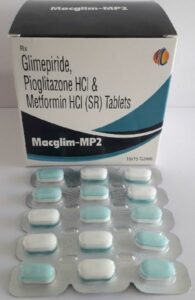Hyperglycemia, a condition characterized by elevated blood sugar levels, is a common concern for individuals with diabetes. Effective management of hyperglycemia often involves a combination of lifestyle changes, including diet exercise, and medications. In this blog, we’ll delve into the world of hyperglycemia medications, exploring the various classes of drugs, their mechanisms of action, and considerations for patients and healthcare professionals.
Contents
- 1 What is Hyperglycemia?
- 2 List of Hyperglycemia Medications
- 2.1 Metformin (Biguanides)
- 2.2 Glyburide (Sulfonylureas)
- 2.3 Sitagliptin (Dipeptidyl Peptidase-4 Inhibitors – DPP-4 Inhibitors)
- 2.4 Canagliflozin (Sodium-Glucose Cotransporter-2 Inhibitors – SGLT2 Inhibitors)
- 2.5 Liraglutide (GLP-1 Receptor Agonists)
- 2.6 Pioglitazone (Thiazolidinediones)
- 2.7 Insulin Aspart (Rapid-Acting Insulin)
- 2.8 Empagliflozin (SGLT2 Inhibitors)
- 2.9 Acarbose (Alpha-Glucosidase Inhibitors)
- 2.10 NPH Insulin (Intermediate-Acting Insulin)
- 2.11 Exenatide (GLP-1 Receptor Agonists)
- 2.12 Glargine U300 Insulin (Long-Acting Insulin)
- 2.13 Saxagliptin (Dipeptidyl Peptidase-4 Inhibitors – DPP-4 Inhibitors)
- 2.14 Insulin Degludec (Ultra-Long-Acting Insulin)
- 2.15 Miglitol (Alpha-Glucosidase Inhibitors)
- 3 How To Take Hyperglycemia Medications?
- 4 Conclusion
What is Hyperglycemia?

Hyperglycemia is a medical condition characterized by elevated levels of glucose (sugar) in the bloodstream. It is commonly associated with diabetes, both type 1 and type 2, but can also occur in other conditions. In individuals with diabetes, the body either does not produce enough insulin (a hormone that helps cells absorb glucose) or does not use insulin effectively. This leads to an accumulation of glucose in the blood, causing hyperglycemia.
Here are the key points to understand about hyperglycemia:
Insulin and Glucose Regulation:
- In a healthy individual, insulin, produced by the pancreas, helps cells absorb glucose from the bloodstream.
- Insulin also facilitates the storage of excess glucose in the liver for later use.
Causes of Hyperglycemia:
- In diabetes, the normal insulin-glucose balance is disrupted, leading to high blood sugar levels.
- In Type 1 Diabetes, the immune system attacks and destroys insulin-producing cells in the pancreas.
- In Type 2 Diabetes, cells become resistant to insulin, and the pancreas may not produce enough insulin.
Symptoms of Hyperglycemia:
- Increased thirst and hunger
- Frequent urination
- Fatigue
- Blurred vision
- Slow healing of wounds
- Unexplained weight loss
List of Hyperglycemia Medications
The primary goal of treating hyperglycemia is to bring blood glucose levels back to within a normal range. Medications used to manage hyperglycemia depend on the type of diabetes and individual health factors. Here are some classes of medications commonly used for hyperglycemia:
Metformin (Biguanides)

Metformin is a widely prescribed medication and belongs to the class of biguanides. It is often the first-line treatment for type 2 diabetes. Metformin works by reducing glucose production in the liver and improving insulin sensitivity in peripheral tissues. It does not increase insulin levels but rather enhances the body’s ability to use available insulin efficiently. This can lead to a decrease in fasting blood glucose levels and improved overall glycemic control. Metformin is known for its safety profile and is generally well-tolerated, with common side effects including gastrointestinal issues such as nausea and diarrhea.
Glyburide (Sulfonylureas)
Sulfonylureas, including glyburide, stimulate insulin secretion from the pancreas, helping to lower blood glucose levels. Glyburide is an oral medication that can be used in the treatment of type 2 diabetes. It acts by closing potassium channels in the beta cells of the pancreas, leading to increased insulin release. While effective, sulfonylureas carry a risk of hypoglycemia (low blood sugar) as a side effect. Therefore, close monitoring of blood glucose levels and proper dose adjustments are essential to prevent complications.
Sitagliptin (Dipeptidyl Peptidase-4 Inhibitors – DPP-4 Inhibitors)
Sitagliptin is a representative medication from the DPP-4 inhibitor class. These drugs work by inhibiting the action of DPP-4, an enzyme that degrades incretin hormones. Incretins play a role in regulating insulin release and reducing glucagon secretion. By inhibiting DPP-4, sitagliptin prolongs the action of incretins, leading to increased insulin production and reduced blood glucose levels. DPP-4 inhibitors are typically used in combination with other diabetes medications and are well-tolerated with a lower risk of hypoglycemia.
Canagliflozin (Sodium-Glucose Cotransporter-2 Inhibitors – SGLT2 Inhibitors)
Canagliflozin is a member of the SGLT2 inhibitor class. These medications act on the kidneys, reducing the reabsorption of glucose and increasing its excretion in the urine. By promoting the removal of excess glucose from the body, SGLT2 inhibitors contribute to lower blood sugar levels. Canagliflozin is also associated with additional benefits such as weight loss and blood pressure reduction. However, it is important to monitor for potential side effects like urinary tract infections and increased risk of genital mycotic infections.
Liraglutide (GLP-1 Receptor Agonists)
Liraglutide is an injectable medication belonging to the GLP-1 receptor agonist class. GLP-1 receptor agonists mimic the action of incretin hormones, stimulating insulin release and inhibiting glucagon secretion. Liraglutide is administered once daily and offers the additional benefit of promoting weight loss. It has been shown to improve blood glucose control and reduce the risk of cardiovascular events. Common side effects include nausea, vomiting, and the possibility of pancreatitis, although this is rare.
Pioglitazone (Thiazolidinediones)

Pioglitazone is a thiazolidinedione that improves insulin sensitivity in peripheral tissues. It works by activating peroxisome proliferator-activated receptor-gamma (PPAR-gamma), which helps regulate genes involved in glucose and lipid metabolism. Pioglitazone is used in the treatment of type 2 diabetes and may be prescribed as a single agent or in combination with other medications. It is known for its potential to improve lipid profiles and has a slower onset of action compared to some other diabetes medications.
Insulin Aspart (Rapid-Acting Insulin)
Insulin aspart is a rapid-acting insulin analog used to manage postprandial (after-meal) glucose levels. It is administered via injection and begins to work quickly, making it suitable for controlling blood sugar spikes after meals. Rapid-acting insulin is often used in combination with long-acting insulin or other oral medications to provide comprehensive glycemic control. Dosage and timing are adjusted based on individual needs and meal patterns.
Empagliflozin (SGLT2 Inhibitors)
Empagliflozin is another medication belonging to the SGLT2 inhibitor class. Similar to canagliflozin, it acts on the kidneys to reduce glucose reabsorption, leading to increased glucose excretion in the urine. SGLT2 inhibitors have shown cardiovascular benefits and are associated with a reduced risk of heart failure in addition to their glucose-lowering effects. However, like other medications, they may be associated with certain side effects, including an increased risk of urinary tract infections.
Acarbose (Alpha-Glucosidase Inhibitors)
Acarbose is an alpha-glucosidase inhibitor that slows down the digestion and absorption of carbohydrates in the small intestine. By delaying the breakdown of complex carbohydrates into glucose, acarbose helps to prevent rapid spikes in blood sugar levels after meals. It is typically taken with meals and is particularly useful for managing postprandial hyperglycemia. Side effects may include gastrointestinal symptoms such as flatulence and diarrhea.
NPH Insulin (Intermediate-Acting Insulin)
NPH insulin is an intermediate-acting insulin that provides a more prolonged effect compared to rapid-acting insulins. It is often used to provide basal (background) insulin coverage between meals and overnight. NPH insulin can be combined with rapid-acting insulins or used in premixed formulations to achieve both basal and prandial (mealtime) insulin coverage. Dosage adjustments are made based on the patient’s specific insulin needs.
Exenatide (GLP-1 Receptor Agonists)
Exenatide is a GLP-1 receptor agonist administered by injection. It mimics the action of incretin hormones, stimulating insulin release and inhibiting glucagon secretion. Additionally, GLP-1 receptor agonists like exenatide slow down gastric emptying and promote a feeling of fullness, contributing to weight loss. Exenatide is commonly prescribed for individuals with type 2 diabetes and is available in both short-acting and extended-release formulations. It offers a convenient once-weekly dosing option, enhancing adherence to the treatment plan.
Despite its efficacy, exenatide may be associated with side effects such as nausea, vomiting, and pancreatitis. Therefore, healthcare professionals carefully evaluate individual patient profiles to determine the suitability of GLP-1 receptor agonists in their treatment regimen.
Glargine U300 Insulin (Long-Acting Insulin)
Glargine U300 is a concentrated form of long-acting insulin glargine. It provides a continuous release of insulin over an extended period, serving as a basal insulin to maintain blood glucose levels between meals and overnight. Glargine U300 offers the advantage of a more stable and prolonged action compared to standard insulin glargine formulations, allowing for once-daily dosing.
This insulin is commonly prescribed for individuals with diabetes who require basal insulin coverage. Like other insulins, dosage adjustments are made based on factors such as blood glucose levels, lifestyle changes, and individual insulin sensitivity. Regular monitoring and collaboration with healthcare providers help ensure optimal glycemic control.
Saxagliptin (Dipeptidyl Peptidase-4 Inhibitors – DPP-4 Inhibitors)
Saxagliptin is a DPP-4 inhibitor that regulates blood sugar levels by inhibiting the degradation of incretin hormones. By extending the action of incretins, saxagliptin enhances insulin release and reduces glucagon secretion. Saxagliptin is taken orally and is commonly used in combination with other antidiabetic medications.
Notably, saxagliptin has been studied in clinical trials for its cardiovascular safety, providing valuable data on its impact on heart health. As with other DPP-4 inhibitors, side effects are generally mild, and the medication is well-tolerated. However, healthcare providers carefully assess patients for any contraindications or potential drug interactions.
Insulin Degludec (Ultra-Long-Acting Insulin)
Insulin degludec is an ultra-long-acting insulin analog that offers a prolonged and consistent release of insulin over an extended duration. It is designed to provide basal insulin coverage for an extended period, exceeding 24 hours. The extended duration of action allows for flexible dosing, providing individuals with diabetes greater flexibility in their daily routines.
Insulin degludec has demonstrated a lower risk of hypoglycemia compared to other long-acting insulins. The reduced variability in blood glucose levels contributes to improved glycemic control. Like other insulins, insulin degludec may be used in combination with rapid-acting insulins or other antidiabetic medications to achieve comprehensive blood sugar management.
Miglitol (Alpha-Glucosidase Inhibitors)
Miglitol is an alpha-glucosidase inhibitor that acts by slowing down the digestion and absorption of carbohydrates in the small intestine. By inhibiting the enzymes responsible for breaking down complex carbohydrates into glucose, miglitol helps to control postprandial (after-meal) blood glucose levels. It is taken with meals and is particularly useful for individuals with type 2 diabetes who experience rapid spikes in blood sugar after eating.
Miglitol is associated with gastrointestinal side effects, including flatulence and diarrhea, which are generally mild and transient. Healthcare providers need to educate patients on proper usage and potential side effects while considering individual patient needs.
How To Take Hyperglycemia Medications?

Taking hyperglycemia medications requires careful adherence to prescribed guidelines for optimal effectiveness. Here’s a general guide:
- Follow the Prescribed Schedule: Adhere to the recommended timing and frequency of medication as advised by your healthcare provider.
- Consistent Timing: Take medications at the same time each day to maintain a routine and enhance effectiveness.
- Monitor Blood Sugar Levels: Regularly check blood glucose levels using the prescribed method to ensure the medication is managing hyperglycemia effectively.
- Dietary Considerations: Take medications with or without food, as directed, and be mindful of dietary guidelines provided by your healthcare team.
- Lifestyle Integration: Integrate medication schedules seamlessly into daily life, considering work, meals, and other routine activities.
- Open Communication: Maintain open communication with healthcare providers. Report any concerns, side effects, or changes in your health promptly.
- Consistency is Key: Consistency in medication adherence and lifestyle factors contributes to better blood sugar control.
- Regular Follow-ups: Attend regular check-ups and follow-ups with healthcare professionals to assess progress and adjust treatment plans as needed.
Conclusion
In conclusion, managing hyperglycemia involves a multifaceted approach tailored to individual needs. Medications such as insulin, oral hypoglycemic agents, and lifestyle adjustments play pivotal roles. Consistent adherence to prescribed medication schedules, regular blood glucose monitoring, and maintaining a healthy lifestyle with proper diet and exercise are paramount.
It is imperative to work collaboratively with healthcare professionals to achieve and maintain a balanced and healthy life.
Do you want to get rid of diabetes? Join our online diabetes treatment program and reverse Diabetes naturally through lifestyle changes such as a Personalized Diet plan, Exercise, Yoga, dieticians, and health coaches.

